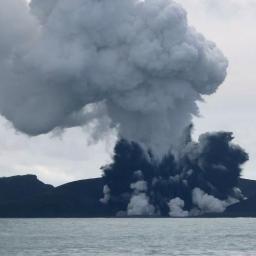
New Yorkers are now renting out their toilets via an Airbnb-inspired app called "Airpnp" that
shows the closest available commode and the price to use it, and instantly contacts the owner. Currently a handful of private addresses in the city offer their johns to any Johnny-come-lately.
The Post located one porcelain throne that bills itself as a "charming Carroll Gardens commode" in a "cozy loft-style bathroom" on Smith Street, Brooklyn, at the OrangeYouGlad graphic-design studio. "You're our first!" yelled art director Connie Leonard excitedly when The Post walked in and asked to use the advertised WC. The OrangeYouGlad crew doesn't charge latrine users - unlike a toilet shark in Little Italy who was charging $20 for people who "really need to go and this will have to do!" The bathroom doesn't even have a sink. A toilet in Woodside, Queens, is more affordable at just $1.

A Tongan volcano has
created a substantial new island since it began erupting last month, spewing out huge volumes of rock and dense ash that has killed nearby vegetation. Tonga is almost 2,000 kilometers (1,243 miles) northeast of New Zealand. It lies on the so-called Pacific "Ring of Fire", where continental plates collide causing frequent volcanic and seismic activity.
The new island is more than one kilometer (0.6 mile) wide, two kilometers (1.2 miles) long and about 100 meters (328 feet) high. During observations the volcano was erupting about every five minutes to a height of about 400 meters (1,312 feet), accompanied by some large rocks...
The volcano rumbled to life on December 20 for the first time in five years, erupting from two vents, one on the uninhabited island of Hunga Ha'apai and the other underwater about 100 meters (328 feet) offshore. A number of international flights were cancelled earlier this week amid concerns about the volcano's ash plume but they resumed on Wednesday, with authorities saying debris from the eruption was not being thrown high into the atmosphere.

A team of scientists from Swinburne University in Melbourne, Australia, has
identified the first ever fast radio burst, sometimes known as a
blitzar, as it happened. These bursts last around one millisecond and give off as much energy as the sun does in a million years.
This blitzar's origin is a mystery, but whatever caused it "must be huge, cataclysmic and up to 5.5 billion light years away," according to researcher Emily Petroff when she spoke to New Scientist. It could be a flare from a giant magnetized neutron star, the collapse of an oversized neutron star, or something else altogether. The data we have reveals that the radiation produced by the blitzar is circularly, not linearly, polaris-which means the waves vibrate in two planes as opposed to one. Which is great! Though nobody knows what on Earth it might mean just yet.
Cone snails are notorious for stinging scuba divers tempted to pick up their beautiful shells. But the geographic cone snail (Conus geographus)-the most venomous cone snail of all, with several human deaths under its belt-takes its practice of poisoning to a whole new level. The tropical sluggard kills by overdosing fish with
a toxic cloud containing insulin. Plummeting blood sugar levels throw the victims into a stupor.
Once the fish are in a sugar coma, the cone snail reaches out with what's called a false mouth-it looks like it's throwing a cape over its prey-and drags a stupefied animal into its mouth. The snail then stings the fish with another set of toxins, just to make sure its victim is completely paralyzed. Other compounds in cone snail venom produce similar results, but no other animal that researchers know of-except perhaps people-uses insulin to kill like this.
 New Yorkers are now renting out their toilets via an Airbnb-inspired app called "Airpnp" that shows the closest available commode and the price to use it, and instantly contacts the owner. Currently a handful of private addresses in the city offer their johns to any Johnny-come-lately.
New Yorkers are now renting out their toilets via an Airbnb-inspired app called "Airpnp" that shows the closest available commode and the price to use it, and instantly contacts the owner. Currently a handful of private addresses in the city offer their johns to any Johnny-come-lately. 
